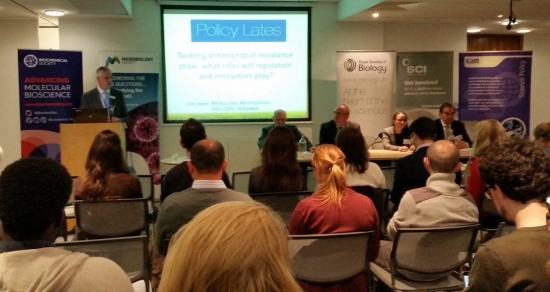News
What role will innovation and regulation play in tackling AMR?
- Details
- 11 October 2016
The widespread use of antibiotics in agriculture was identified as a key area of concern at the Society’s ‘Policy Lates’ event on antimicrobial resistance (AMR) last night. It was also agreed that antibiotics are overused in human health.

A panel of expert speakers and delegates from across the life sciences gathered as part of Biology Week to debate how regulation and innovation can help tackle the antimicrobial resistance crisis.
Professor Mark Fielder, an advisor for the Clinical and Laboratory Sciences Institute and AMR expert, said in the USA up to 70% of antibiotic consumption was non-human because the drugs increase animal growth and meat yields by 10%.
“We have AMR moving between the animal and human world and we don’t look at that enough. We need to take a ‘one health view’ – think of the human, the environment and the animal, instead of thinking of them separately.”
The use of antibiotics as growth promoters was banned in the EU in 2006, but Professor Fielder said that the veterinary sector was ‘not as tightly controlled’ as the human health and medicine sector because practices are private. “Surveillance is expensive but it needs to happen to keep a lid on this and keep that lid shut tight.”
John Broughall, from Antibiotic Research UK, explained how the Yorkshire-based charity is screening old antibiotics and other compounds in the hope of finding ‘antibiotic resistance breakers’ – drugs which can disrupt organisms’ resistance mechanisms. This could lead to existing drugs being co-administered alongside failing antibiotics to boost their efficacy, a potential solution which would cost a fraction of the cost of developing a new antibiotic.
Tamar Ghosh, lead of the Longitude Prize, explained how the £10m fund will be awarded to scientists who within five years can develop a rapid, affordable, point of care diagnostic to reduce overuse of antibiotics. Last year the general public voted for the prize to focus on antimicrobial resistance from six shortlisted challenges to humanity, and it has so far attracted 205 teams from 39 countries.
“What’s great about those teams is that they are not all led by who you’d expect,” said Ghosh. “They’re not all microbiologists – there’s a great mix from industry, academia, people have come out of retirement, people are resurrecting old ideas. They are forming new consortia and new collaborations of engineers, chemists, physicists, social scientists.”
But Tamar Ghosh said that a diagnostic on its own 'is not going to solve the problem if people are not aware of it, if we don’t use the diagnostic collectively, and act on the result.'
The discussion moved between many related topics, such as the availability of online antibiotics, the pressure on GPs to prescribe antibiotics without proper diagnosis, the use of synthetic biology and phage therapy in novel antibiotics, and the thorny issue of why developing new antibiotics is not worth the investment for pharmaceutical companies.
“The payback period for an antibiotic is something like 23 years,” said the debate’s chair, Professor Jeff Cole, vice-president of the European Federation of Biotechnology. “As the O’Neill report concluded, you have to break the link between sales and research and development – although he did not come up with a solution, other than creating a global fund.”
The panel heard from the floor about how access to antibiotics has been restricted with some success in countries like Norway. But John Broughall made the point that many countries do not have the infrastructure to govern the use of antibiotics. “We can do whatever we want here but that resistance is only a six hour flight away,” he said.
Tamar Ghosh added the salient point that many more people die from a lack of access to antibiotics than from resistance issues, a factor which will undoubtedly make global cooperation on the issue difficult.
This event was organised by the UK members of the European Federation of Biotechnology in association with the Learned Society Partnership on AMR.
Further reading:
Innovation: a new way to fight antimicrobial resistance (7 October 2016)
UN agrees to take action on antimicrobial resistance (29 September 2016)

